Evaluation of Vitamin D isolated or Associated with Teriparatide in Peri-Implant Bone Repair in Tibia of Orchiectomized Rats
Abstract
Simple Summary
Abstract
1. Introduction
2. Materials and Methods
2.1. Animals
2.2. Bilateral Orchiectomy
2.3. Drug Treatment
2.4. Surgery to Install Implants in Tibias of Rats
2.5. Microtomographic Analysis (Micro-CT)
2.6. Preparation of Calcified Tissues
2.7. Acid Etching and Scanning Electron Microscopy (SEM)
2.8. Statistical Analysis
3. Results
3.1. Micro CT
3.2. Scanning Electron Microscopy (SEM)
4. Discussion
5. Conclusions
Author Contributions
Funding
Institutional Review Board Statement
Informed Consent Statement
Data Availability Statement
Acknowledgments
Conflicts of Interest
References
- Drage, N.A.; Palmer, R.M.; Blake, G.; Wilson, R.; Crane, F.; Fofelman, I. A comparision of bone mineral desity in the spine, hid and jaws of edentulous subjects. Clin. Oral Implant. Res. 2007, 18, 496–500. [Google Scholar] [CrossRef] [PubMed]
- Tabata, L.F.; Rocha, E.P.; Barao, V.A.; Assuncao, W.G. Platform switching: Biomechanical evaluation using three-dimensional finite element analysis. Int. J. Oral Maxillofac. Implant. 2011, 26, 482–491. [Google Scholar]
- Overmann, A.L.; Aparicio, C.; Richards, J.T.; Mutreja, I.; Fischer, N.G.; Wade, S.M.; Potter, B.K.; Davis, T.A.; Bechtold, J.E.; Forsberg, J.A.; et al. Orthopaedic osseointegration: Implantology and future directions . Orthop. Res. Soc. 2020, 38, 1445–1454. [Google Scholar] [CrossRef] [PubMed]
- Guglielmotti, M.B.; Olmedo, D.G.; Cabrini, R.L. Research on implants and osseointegration. Periodontology 2019, 79, 178–189. [Google Scholar] [CrossRef] [PubMed]
- Drake, M.T.; Khosla, S. Male osteoporosis. Endocrinol. Metab. Clin. N. Am. 2012, 41, 629–641. [Google Scholar] [CrossRef]
- Giusti, A.; Bianchi, G. Treatment of primary osteoporosis in men. Clin. Interv. Aging 2014, 10, 105–115. [Google Scholar]
- Kanis, J.A.; Kani, J.A. Assessment of fracture risk and its application to screening for postmenopausal osteoporosis: Synopsis of a WHO report. Osteoporos. Int. 1994, 4, 368–381. [Google Scholar] [CrossRef]
- Schousboe, J.T.; Shepherd, J.A.; Bilezikian, J.P.; Baim, S. Executive summary of the 2013 International Society for Clinical Densitometry Position Development Conference on bone densitometry. J. Clin. Densitom. 2013, 16, 455–466. [Google Scholar] [CrossRef]
- Siris, E.S.; Adler, R.; Bilezikian, J.; Bolognese, M.; Dawson-Hughes, B.; Favus, M.J.; Harris, S.T.; de Beur, S.M.J.; Khosla, S.; Lane, N.E.; et al. The clinical diagnosis of osteoporosis: A position statement from the National Bone Health Alliance Working Group. Osteoporos. Int. 2014, 25, 1439–1443. [Google Scholar] [CrossRef]
- Mittan, D.; Lee, S.; Miller, E.; Perez, R.C.; Basler, J.W.; Bruder, J.M. Bone loss following hypogonadism in men with prostate cancer treated with GnRH analogs. J. Clin. Endocrinol. Metab. 2002, 87, 3656–3666. [Google Scholar] [CrossRef]
- Kaufman, J.M.; Lapauw, B.; Goemaere, S. Current and future treatments of osteoporosis in men. Best Pract. Res. Clin. Endocrinol. Metab. 2014, 28, 871–884. [Google Scholar] [CrossRef]
- Gielen, E.; Vanderschueren, D.; Callewaert, F.; Boonen, S. Osteoporosis in men. Best practice & research. Clin. Endocrinol. Metab. 2011, 25, 321–335. [Google Scholar]
- Riggs, B.L.; Khosla, S.; Melton, L.J. Sex steroids and the construction and conservation of the adult skeleton. Endocr. Rev. 2002, 23, 279–302. [Google Scholar] [CrossRef]
- Van Pottelbergh, I.; Goemaere, S.; Kaufman, J.M. Bioavailable estradiol and an aromatase gene polymorphism are determinants of bone mineral density changes in men over 70 years of age. J. Clin. Endocrinol. Metab. 2003, 88, 3075–3081. [Google Scholar] [CrossRef]
- Gennari, L.; Nuti, R.; Bilezikian, J.P. Aromatase activity and bone homeostasis in men. J. Clin. Endocrinol. Metab. 2004, 89, 5898–6590. [Google Scholar] [CrossRef]
- Vanderschueren, D.; Vandenput, L.; Boonen, S.; Lindberg, M.K.; Bouillon, R.; Ohlsson, C. Androgens and bone. Endocr. Rev. 2004, 25, 389–425. [Google Scholar] [CrossRef]
- Mohamad, N.V.; Soelaiman, I.N.; Chin, K.Y. A concise review of testosterone and bone health. Clin Interv Aging. 2016, 11, 1317–1324. [Google Scholar] [CrossRef]
- Kaufman, J.M.; Goemaere, S. Osteoporosis in men. Best Pract. Res. Clin. Endocrinol. Metab. 2008, 22, 787812. [Google Scholar] [CrossRef]
- Yeh, P.S.; Lee, Y.W.; Chang, W.H.; Wang, W.; Wang, J.L.; Liu, S.H.; Chen, R.M. Biomechanical and tomographic differences in the microarchitecture and strength of trabecular and cortical bone in the early stage of male osteoporosis. PloS ONE 2019, 14, e0219718. [Google Scholar] [CrossRef]
- Banu, J. Causes, consequences, and treatment of osteoporosis in men. Drug Des. Dev. Ther. 2013, 7, 849–860. [Google Scholar] [CrossRef]
- Bikle, D.D.; Adams, J.; Christakos, S. Vitamin D: Production, metabolism and clinical requirements. In Primer on Metabolic Bone Diseases, 8th ed.; Rosen, M.D., Clifford, J., Eds.; American Society for Bone and Mineral Research: Hoboken, NJ, USA, 2013; pp. 235–245. [Google Scholar]
- Plum, L.A.; DeLuca, H.F. Vitamin D, disease and therapeutic opportunities. Nat. Rev. Drug. Discov. 2010, 9, 941–955. [Google Scholar] [CrossRef] [PubMed]
- Pattanaungkul, S.; Riggs, B.L.; Yergey, A.L.; Vieira, N.E.; O’Fallon, W.M.; Khosla, S. Relationship of intestinal calcium absorption to 1,25-dihydroxyvitamin D [1,25(OH)2D] levels in young versus elderly women: Evidence for age-related intestinal resistance to 1,25(OH)2D action. J. Clin. Endocrinol. Metab. 2000, 85, 4023–4027. [Google Scholar] [CrossRef] [PubMed]
- Muñoz-Garach, A.; García-Fontana, B.; Muñoz-Torres, M. Nutrients and Dietary Patterns Related to Osteoporosis. Nutrients 2020, 12, 1986. [Google Scholar] [CrossRef] [PubMed]
- Muscogiuri, G.; Barrea, L.; Altieri, B.; Di Somma, C.; Bhattoa, H.P.; Laudisio, D.; Duval, G.T.; Pugliese, G.; Annweiler, C.; Orio, F.; et al. Calcium and Vitamin D Supplementation. Myths and Realities with Regard to Cardiovascular Risk. Curr. Vasc. Pharmacol. 2019, 17, 610–617. [Google Scholar] [CrossRef]
- Weaver, C.M.; Alexander, D.D.; Boushey, C.J.; Dawson-Hughes, B.; Lappe, J.M.; LeBoff, M.S.; Liu, S.; Looker, A.C.; Wallace, T.C.; Wang, D.D. Calcium plus vitamin D supplementation and risk of fractures: An updated meta-analysis from the National Osteoporosis Foundation. Osteoporos. Int. 2016, 27, 367–376. [Google Scholar] [CrossRef]
- Veldurthy, V.; Wei, R.; Oz, L.; Dhawan, P.; Jeon, Y.H.; Christakos, S. Vitamin D, calcium homeostasis and aging. Bone Res. 2016, 18, 16041. [Google Scholar] [CrossRef]
- Frigério, P.B.; Gomes-Ferreira, P.H.S.; de Souza Batista, F.R.; Moura, J.; Rangel Garcia Júnior, I.; Botticelli, D.; Lisboa-Filho, P.N.; Okamoto, R. Effect of Topical PTH 1-34 Functionalized to Biogran® in the Process of Alveolar Repair in Rats Submitted to Orchiectomy. Materials 2021, 15, 207. [Google Scholar] [CrossRef]
- Koca, C.G.; Sadry, S.; Asker, H.; Çiçek, M.F.; Kösehasanoğulları, M.; Kaya, G. Effects of the different administration frequencies of teriparatide (PTH [1-34]) on new bone formation of expanded midpalatal sutures in rats: A histomorphometric and micro-computed tomography analysis. Orthod. Craniofacial Res. 2021, 24, 449–457. [Google Scholar] [CrossRef]
- Farahmand, P.; Spiegel, R.; Ringe, J.D. Male osteoporosis. Z. Rheumatol. 2016, 75, 459–465. [Google Scholar] [CrossRef]
- Niimi, R.; Kono, T.; Nishihara, A.; Hasegawa, M.; Matsumine, A.; Kono, T.; Sudo, A. Analysis of daily teriparatide treatment for osteoporosis in men. Osteoporos. Int. 2015, 26, 1303–1309. [Google Scholar] [CrossRef]
- Yamamoto, T.; Tsujimoto, M.; Hamaya, E.; Sowa, H. Assessing the effect of baseline status of serum bone turnover markers and vitamin D levels on efficacy of teriparatide 20 μg/day administered subcutaneously in Japanese patients with osteoporosis. J. Bone Miner. Metab. 2013, 31, 199–205. [Google Scholar] [CrossRef]
- Bislev, L.S.; Sikjaer, T.; Rejnmark, L. Effects on calcium homeostasis of changing PTH replacement therapy of postoperative hypoparathyroidism from intact PTH to teriparatide: A case series. Calcif. Tissue Int. 2014, 95, 374–381. [Google Scholar] [CrossRef]
- Cosman, F.; Dawson-Hughes, B.; Wan, X.; Krege, J.H. Changes in vitamin D metabolites during teriparatide treatment. Bone 2012, 50, 1368–1371. [Google Scholar] [CrossRef]
- Gomes-Ferreira, P.H.S.; de Oliveira, D.; Frigério, P.B.; de Souza Batista, F.R.; Grandfield, K.; Okamoto, R. Teriparatide improves microarchitectural characteristics of peri-implant bone in orchiectomized rats. Osteoporos. Int. 2020, 31, 1807–1815. [Google Scholar] [CrossRef]
- de Oliveira Puttini, I.; Gomes-Ferreira, P.H.S.; de Oliveira, D.; Hassumi, J.S.; Gonçalves, P.Z.; Okamoto, R. Teriparatide improves alveolar bone modelling after tooth extraction in orchiectomized rats. Arch. Oral Biol. 2019, 102, 147–154. [Google Scholar] [CrossRef]
- de Oliveira, D.; de Oliveira Puttini, I.; Silva Gomes-Ferreira, P.H.; Palin, L.P.; Matsumoto, M.A.; Okamoto, R. Effect of intermittent teriparatide (PTH 1-34) on the alveolar healing process in orchiectomized rats. Clin. Oral. Investig. 2019, 23, 2313–2322. [Google Scholar] [CrossRef]
- Zhou, C.; Li, Y.; Wang, X.; Shui, X.; Hu, J. 1,25Dihydroxy vitamin D(3) improves titanium implant osseointegration in osteoporotic rats. Oral Surg. Oral Med. Oral Pathol. Oral Radiol. 2012, 114 (Suppl. 5), S174–S178. [Google Scholar] [CrossRef]
- Micheletti, C.; Gomes-Ferreira, P.H.S.; Casagrande, T.; Lisboa-Filho, P.N.; Okamoto, R.; Grandfield, K. From tissue retrieval to electron tomography: Nanoscale characterization of the interface between bone and bioactive glass. J. R. Soc. Interface 2021, 18, 20210181. [Google Scholar] [CrossRef]
- Cui, J.; Yang, Y.; Chen, P.; Hang, R.; Xiao, Y.; Liu, X.; Zhang, L.; Sun, H.; Bai, L. Differential Nanoscale Topography Dedicates Osteocyte-Manipulated Osteogenesis via Regulation of the TGF-β Signaling Pathway. Int. J. Mol. Sci. 2022, 23, 4212. [Google Scholar] [CrossRef]
- Bouxsein, M.L.; Boyd, S.K.; Christiansen, B.A.; Guldberg, R.E.; Jepsen, K.J.; Müller, R. Guidelines for assessment of bone microstructure in rodents using micro-computed tomography. J. Bone Miner. Res. 2010, 25, 1468–1486. [Google Scholar] [CrossRef]
- Von Wowern, N.; Kollerup, G. Symptomatic osteoporosis: A risk factor for residual ridge reduction of the jaws. J. Prosthet. Dent. 1992, 67, 656–660. [Google Scholar] [CrossRef] [PubMed]
- Shapurian, T.; Damoulis, P.D.; Reiser, G.M.; Griffin, T.J.; Rand, W.M. Quantitative evaluation of bone density using the Hounsfield index. Int. J. Oral Maxillofac. Implant. 2006, 21, 290–297. [Google Scholar]
- Lirani-Galvão, A.P.; Lazaretti-Castro, M. Physical approach for prevention and treatment of osteoporosis. Arq. Bras. Endocrinol. Metabol. 2010, 54, 171–178. [Google Scholar] [CrossRef] [PubMed]
- Finkelstein, J.S.; Hayes, A.; Hunzelman, J.L.; Wyland, J.J.; Lee, H.; Neer, R.M. The effects of parathyroid hormone, alendronate, or both in men with osteoporosis. N. Engl. J. Med. 2003, 349, 1216–1226. [Google Scholar] [CrossRef]
- Finkelstein, J.S.; Leder, B.Z.; Burnett, S.M.; Wyland, J.J.; Lee, H.; de la Paz, A.V.; Gibson, K.; Neer, R.M. Effect of teriparatide, alendronate, or both on bone turnover in osteoporotic men. J. Clin. Endocrinol. Metab. 2006, 91, 2882–2887. [Google Scholar] [CrossRef]
- Yamazaki, M.; Shirota, T.; Tokugawa, Y.; Motohashi, M.; Ohno, K.; Michi, K.; Yamaguchi, A. Bone reactions to titanium screw implants in ovariectomized animals. Oral Surg. Oral Med. Oral Pathol. Oral Radiol. Endod. 1999, 87, 411–418. [Google Scholar] [CrossRef]
- Ozawa, S.; Ogawa, T.; Iida, K.; Sukotjo, C.; Hasegawa, H.; Nishimura, R.D.; Nishimura, I. Ovariectomy hinders the early stage of bone-implant integration: Histomorphometric, biomechanical, and molecular analyses. Bone 2002, 30, 137–143. [Google Scholar] [CrossRef]
- Ramalho-Ferreira, G.; Faverani, L.P.; Prado, F.B.; Garcia, I.R., Jr.; Okamoto, R. Raloxifene enhances peri-implant bone healing in osteoporotic rats. Int. J. Oral Maxillofac. Surg. 2015, 44, 798–805. [Google Scholar] [CrossRef]
- Cosman, F. Anabolic and antiresorptive therapy for osteoporosis: Combination and sequential approaches. Curr. Osteoporos. Rep. 2014, 12, 385–395. [Google Scholar] [CrossRef]
- Shah, F.A.; Thomsen, P.; Palmquist, A. A Review of the Impact of Implant Biomaterials on Osteocytes. J. Dent. Res. 2018, 97, 977–986. [Google Scholar] [CrossRef]
- Rios, H.F.; Ye, L.; Dusevich, V.; Eick, D.; Bonewald, L.F.; Feng, J.Q. DMP1 is essential for osteocyte formation and function. J. Musculoskelet. Neuronal Interact. 2005, 5, 325–327. [Google Scholar]
- Bonewald, L.F. Generation and function of osteocyte dendritic processes. J. Musculoskelet. Neuronal Interact. 2005, 4, 321–324. [Google Scholar]
- Shah, F.A.; Wang, X.; Thomsen, P.; Grandfield, K.; Palmquist, A. High-Resolution Visualization of the Osteocyte Lacuno-Canalicular Network Juxtaposed to the Surface of Nanotextured Titanium Implants in Human. ACS Biomater. Sci. Eng. 2015, 1, 305–313. [Google Scholar] [CrossRef]
- Du, Z.; Ivanovski, S.; Hamlet, S.M.; Feng, J.Q.; Xiao, Y. The ultrastructural relationship between osteocytes and dental implants following osseointegration. Clin. Implant. Dent. Relat. Res. 2014, 18, 270–280. [Google Scholar] [CrossRef]
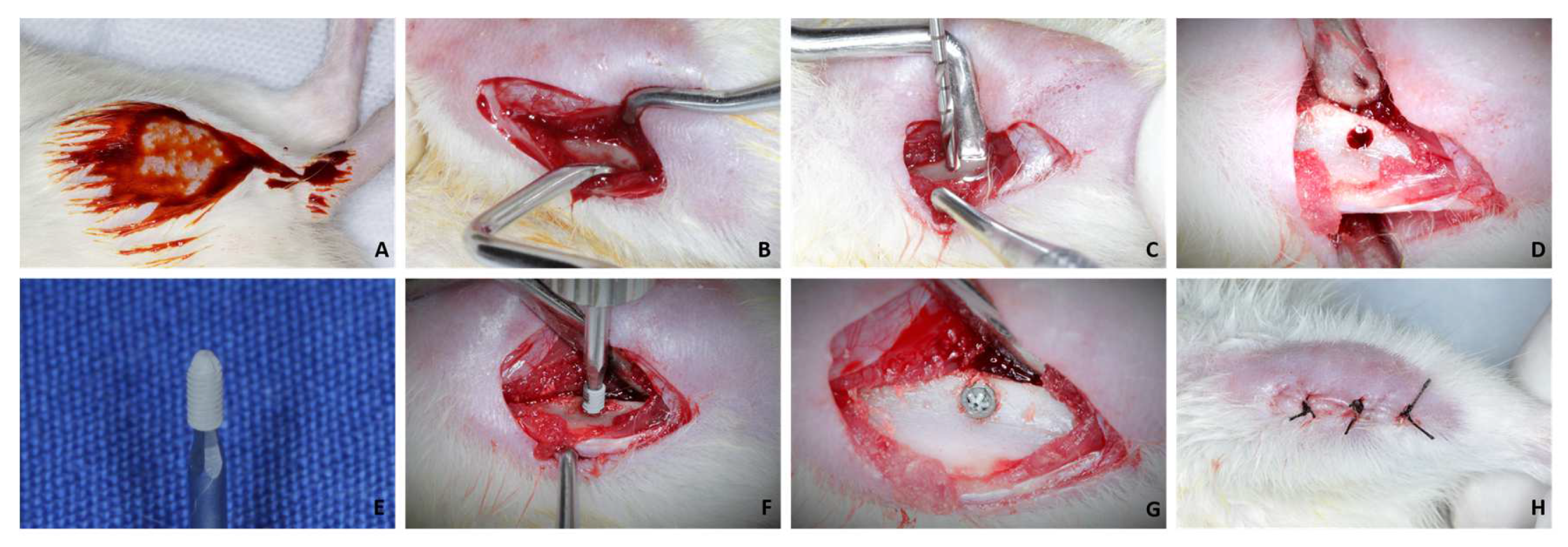


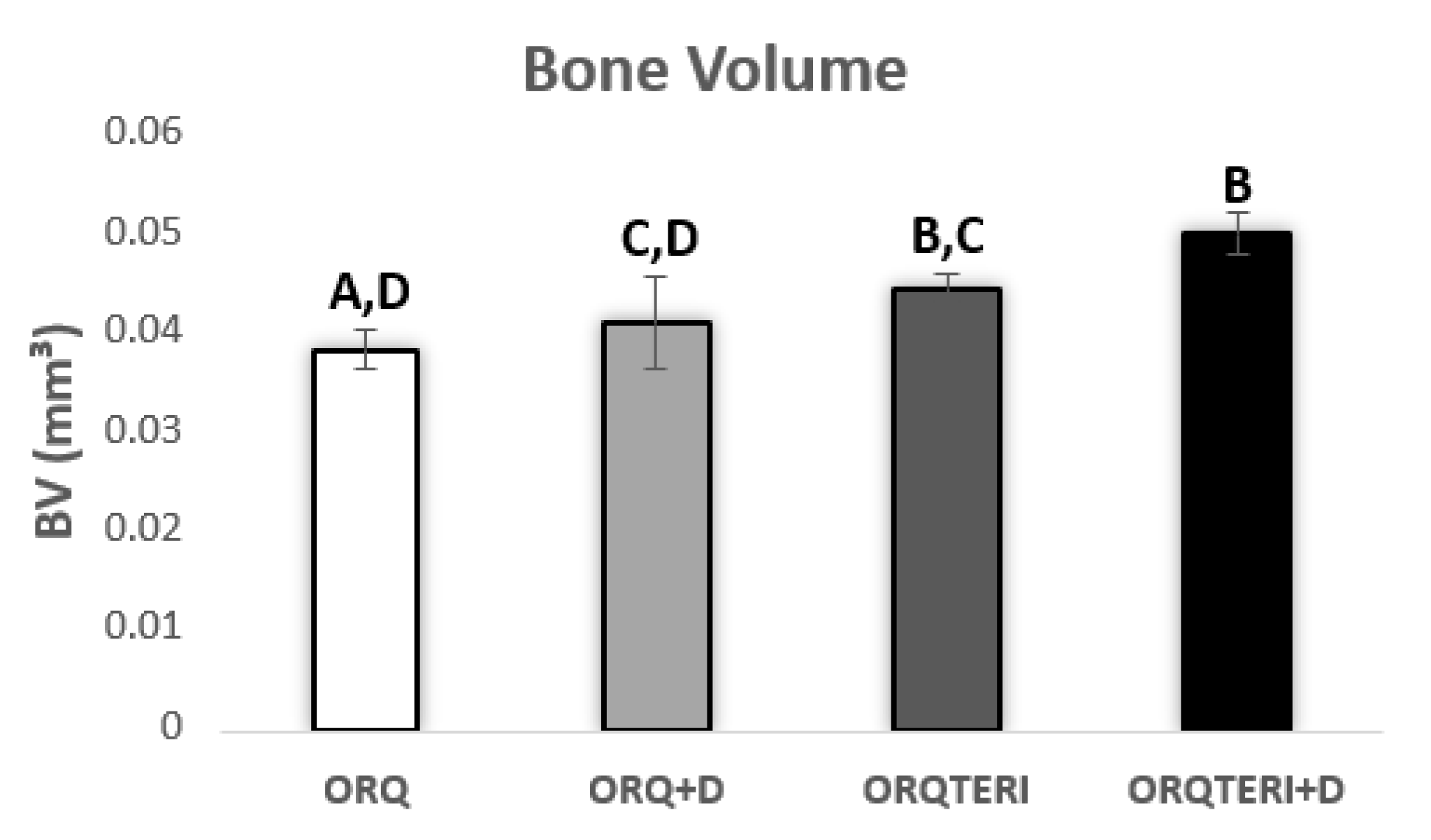

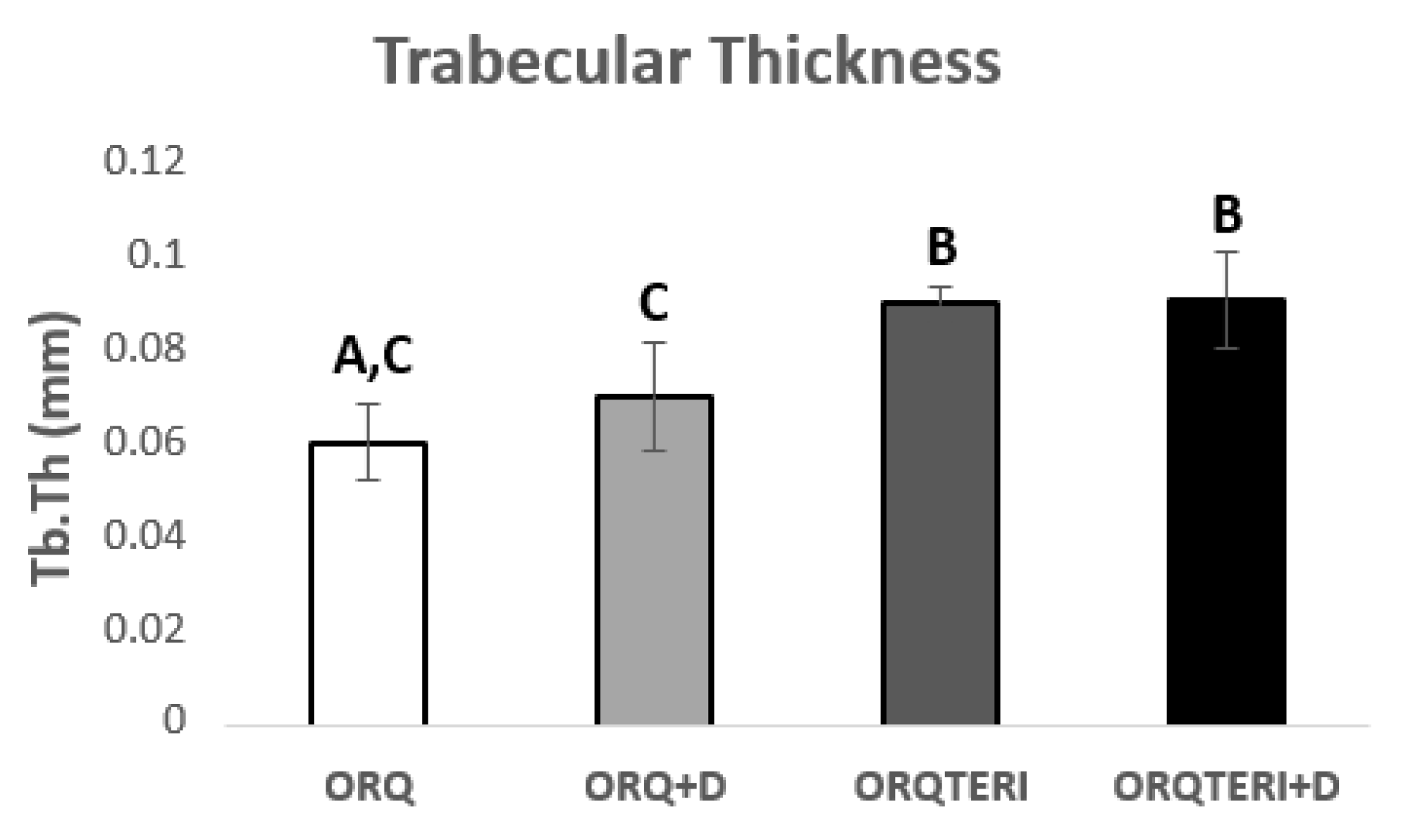
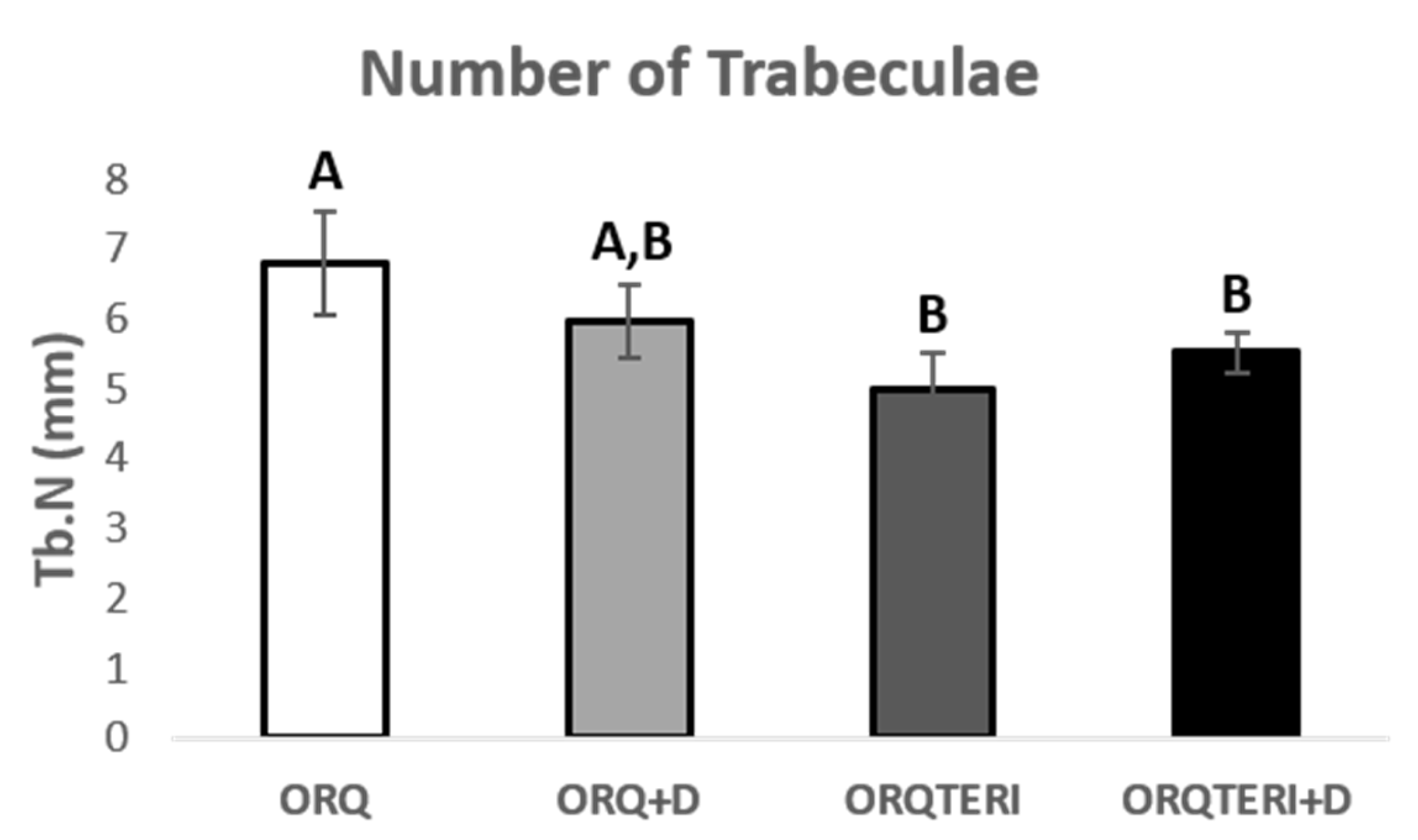
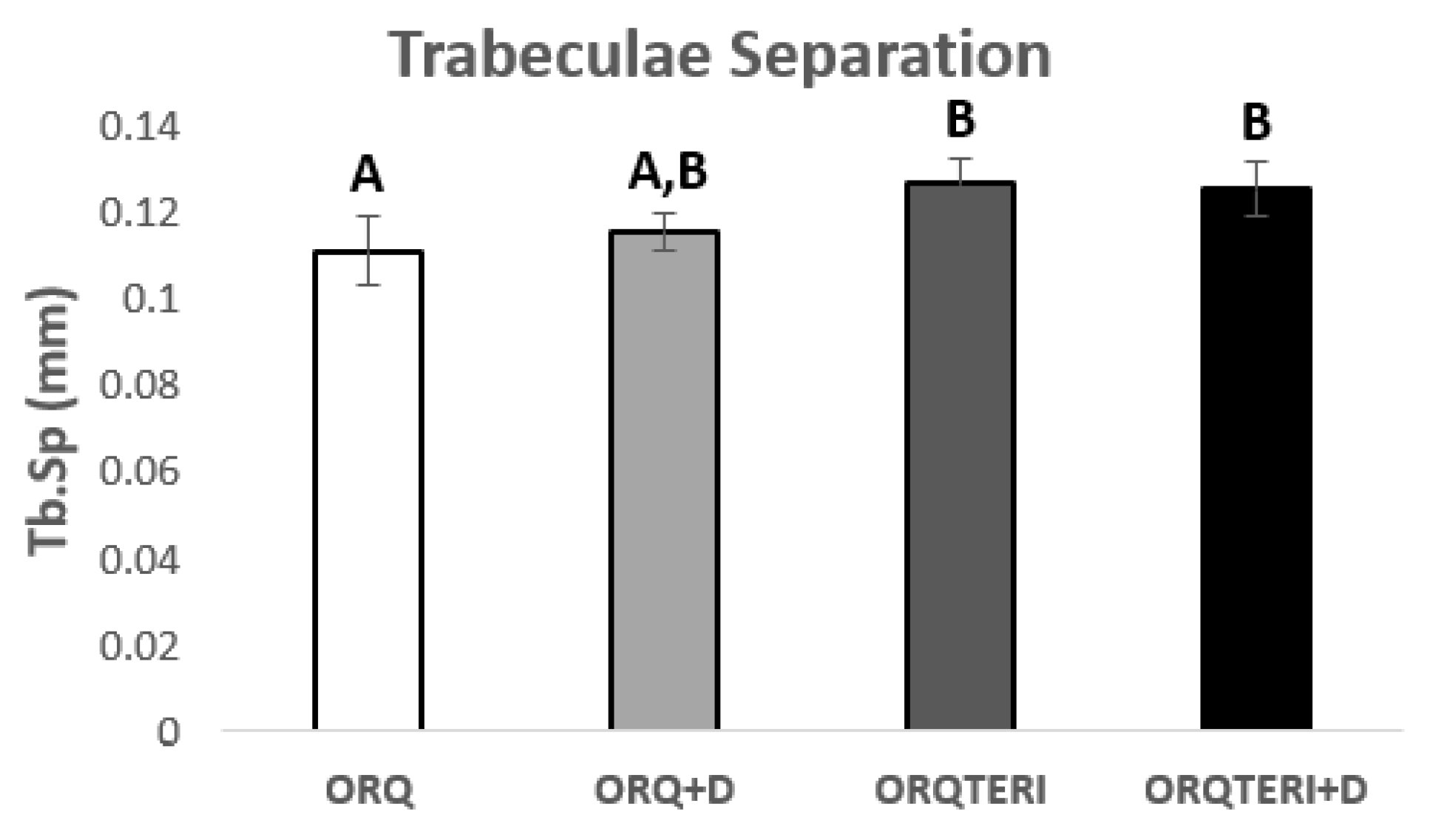
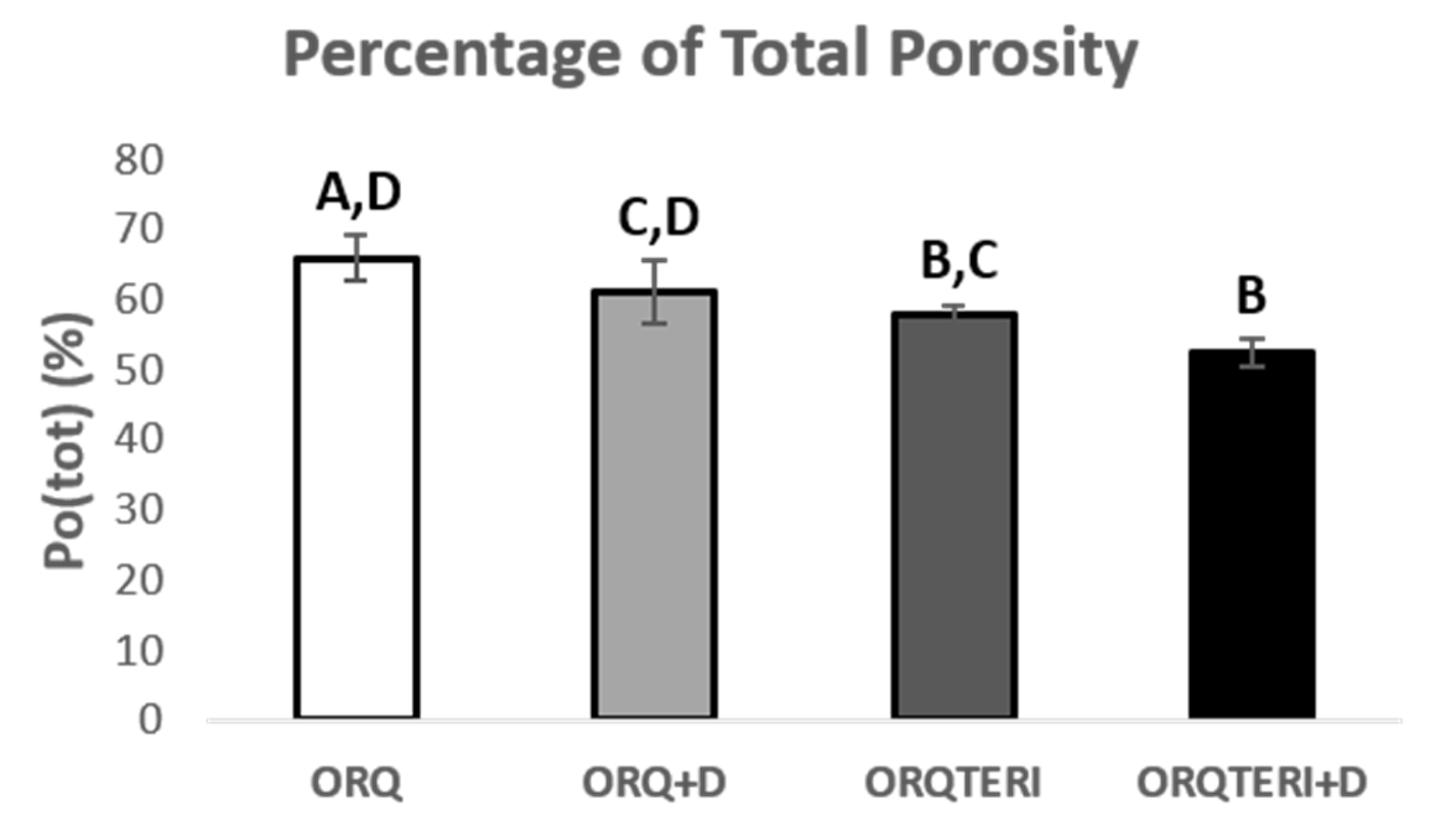

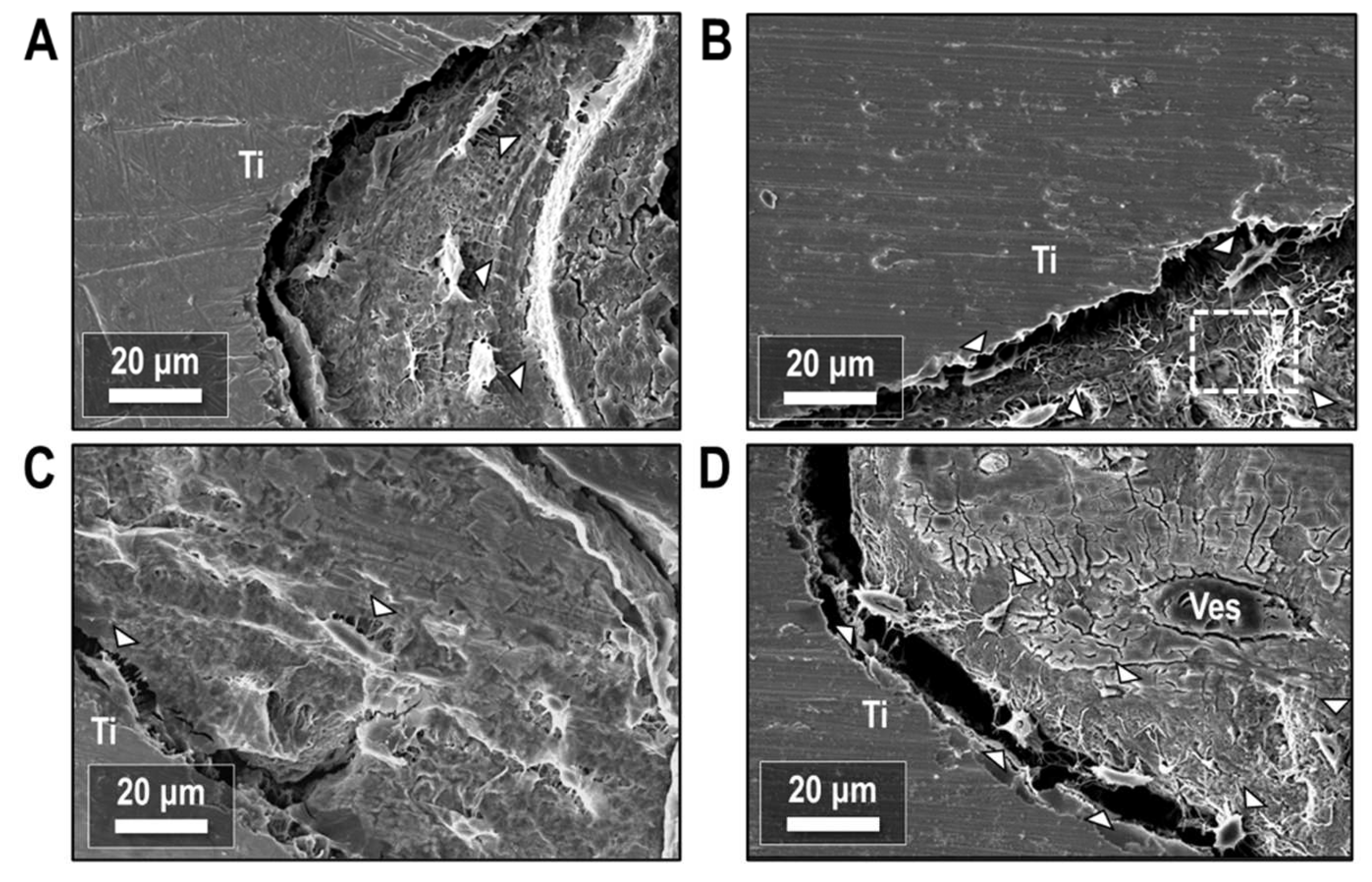

| Groups | Description |
|---|---|
| ORQ (n = 6) | Rats submitted to orchiectomy that did not receive drug treatment. |
| ORQ+D (n = 6) | Rats submitted to orchiectomy that received vitamin D (dose 0.1 mcg/kg/day). |
| ORQTERI (n = 6) | Rats submitted to orchiectomy that received teriparatide (dose 0.5 mcg/kg/day). |
| ORQTERI+D (n = 6) | Rats submitted to orchiectomy that received teriparatide (dose 0.5 mcg/kg/day) and vitamin D (dose 0.1 mcg/kg/day). |
Disclaimer/Publisher’s Note: The statements, opinions and data contained in all publications are solely those of the individual author(s) and contributor(s) and not of MDPI and/or the editor(s). MDPI and/or the editor(s) disclaim responsibility for any injury to people or property resulting from any ideas, methods, instructions or products referred to in the content. |
© 2023 by the authors. Licensee MDPI, Basel, Switzerland. This article is an open access article distributed under the terms and conditions of the Creative Commons Attribution (CC BY) license (https://creativecommons.org/licenses/by/4.0/).
Share and Cite
Gomes-Ferreira, P.H.S.; Frigério, P.B.; de Moura, J.; Duarte, N.D.; de Oliveira, D.; Deering, J.; Grandfield, K.; Okamoto, R. Evaluation of Vitamin D isolated or Associated with Teriparatide in Peri-Implant Bone Repair in Tibia of Orchiectomized Rats. Biology 2023, 12, 228. https://doi.org/10.3390/biology12020228
Gomes-Ferreira PHS, Frigério PB, de Moura J, Duarte ND, de Oliveira D, Deering J, Grandfield K, Okamoto R. Evaluation of Vitamin D isolated or Associated with Teriparatide in Peri-Implant Bone Repair in Tibia of Orchiectomized Rats. Biology. 2023; 12(2):228. https://doi.org/10.3390/biology12020228
Chicago/Turabian StyleGomes-Ferreira, Pedro Henrique Silva, Paula Buzo Frigério, Juliana de Moura, Nathália Dantas Duarte, Danila de Oliveira, Joseph Deering, Kathryn Grandfield, and Roberta Okamoto. 2023. "Evaluation of Vitamin D isolated or Associated with Teriparatide in Peri-Implant Bone Repair in Tibia of Orchiectomized Rats" Biology 12, no. 2: 228. https://doi.org/10.3390/biology12020228
APA StyleGomes-Ferreira, P. H. S., Frigério, P. B., de Moura, J., Duarte, N. D., de Oliveira, D., Deering, J., Grandfield, K., & Okamoto, R. (2023). Evaluation of Vitamin D isolated or Associated with Teriparatide in Peri-Implant Bone Repair in Tibia of Orchiectomized Rats. Biology, 12(2), 228. https://doi.org/10.3390/biology12020228









